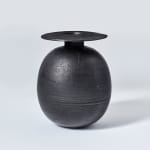Hans Coper 1920-1981
diameter: 13 cm / 5 ¼in.
Further images
From his earliest encounters with clay Coper sought to hone his understanding of form and surface, and the interplay between the two. Writing in the introduction to his 1969 Victoria and Albert Museum exhibition, shared with the textile artist Peter Collingwood, he wrote ‘My concern is with extracting essence rather than with experiment and exploration’. During his career he worked with a small repertoire of different forms – spades, bowls, ‘cycladic’ arrow-heads, bottle vases, and ovoid forms – of which this is an impressive example dating from the early 1970s. Thrown in a thickly grogged stoneware clay, Coper then worked the surface by turning and incising the form, seen here in the ‘rings’ that run around the belly of the piece balancing and grounding the form while simultaneously offering a very architectural presence to the work. By this period Coper was working mostly in two palettes – the first, a lighter worked creamy surface rubbed with engobes and manganese, and the second a rich black, as seen in the present work. It is these all-black forms that cast impressive and powerful silhouettes – seen in examples such as the Spade Form housed in The Victoria & Albert Museum, London and Bottle Form from the collection of The Fitzwilliam Museum, Cambridge.
Coper rarely wrote or spoke about his work, instead preferring to let the forms speak truly for themselves, but in the introduction to his 1969 Victoria & Albert Museum exhibition the artist discussed a pot from the pre-dynastic Egyptian era ‘roughly egg-shaped, the size of my hand : made thousands of years ago’. Drawn to its ‘humble, passive’ nature, one can imagine that such a piece sat in the back of his mind as he explored the series of ovoid forms made in the 1960s and into the ‘70s, such as the present work. Just as the Egyptian pot, this roughly hand-sized pot makes a bold and powerful statement. It is a work by an artist that looks both backwards and forwards, and a piece that brilliantly showcases his own unique understanding and interpretation of the materiality and versatility of clay.
Coper achieved widespread recognition during his lifetime, with exhibitions held across Europe and North America, and following his death in 1981 a travelling retrospective exhibition was mounted at The Sainsbury Centre for Visual Arts, Norwich (home to the renowned collection of Robert and Lisa Sainsbury), which toured to the Hetjens Museum, Düsseldorf, the Boijmans Van Beuningen Museum, Rotterdam; and the Serpentine Gallery, London. Much like his contemporary Lucie Rie, Coper blurred the lines between art and craft, and his ceramic creations carry as much gravitas as any sculpture produced in the period. In his work he distilled from history, epitomising his process of, as he put it, ‘extracting essence’. Coper’s forms have, on one level, a hard-achieved simplicity, but they also suggest a votive presence, an almost hieratic quality that gives his best work a powerful and all-pervasive mystery.
Provenance
Kunstkammer Kösters, Moenchengladbach
Private Collection, Germany
Hagesheimer & Günther, Duesseldorf
Private Collection, Germany
Exhibitions
London, Offer Waterman, On Foot: An Exhibition Curated by Jonathan Anderson, September – October 2023.
Literature
Tony Birks, Hans Coper, Marston House, Yeovil, 1983, 2005, illustrated p.67, a closely comparable work;
Kiriko Nishida et.al., Hans Coper Retrospective, The Museum of Ceramic Art, Hyogo, 2009, illustrated, p.107, a closely comparable work;
Mienke Simon
Thomas, The Essential Potness: Lucie Rie and Han Coper in Museum Boijmans
Van Beuningen, Rotterdam, 2014, illlustrated p.171, a closely comparable
work;
Jonathan Anderson et.al., On Foot: An Exhibition Curated by Jonathan
Anderson, Offer Waterman, London, 2023, illustrated p.25.
Join our mailing list
* denotes required fields
We will process the personal data you have supplied to communicate with you in accordance with our Privacy Policy. You can unsubscribe or change your preferences at any time by clicking the link in our emails.





